| کد مقاله | کد نشریه | سال انتشار | مقاله انگلیسی | نسخه تمام متن |
|---|---|---|---|---|
| 1269837 | 972464 | 2014 | 15 صفحه PDF | دانلود رایگان |

• Ultrasound-assisted heterogeneous solid catalyzed (CaO) synthesis of biodiesel from crude Jatropha curcas oil.
• XRD analysis confirms formation of Ca(OMe)2, active catalyst for transesterification.
• Highest yield at molar ratio ≈ 11, temperature ≈ 64 °C, catalyst loading ≈ 5.5 wt.%.
• The activation energy of the reaction is calculated as 133.5 kJ/mol.
• A 4× increase in activation energy than homogeneous catalytic system due to heterogeneity of system.
This paper reports studies in ultrasound-assisted heterogeneous solid catalyzed (CaO) synthesis of biodiesel from crude Jatropha curcas oil. The synthesis has been carried out in two stages, viz. esterification and trans-esterification. The esterification process is not influenced by ultrasound. The transesterification process, however, shows marked enhancement with ultrasound. A statistical experimental design has been used to optimize the process conditions for the synthesis. XRD analysis confirms formation of Ca(OMe)2, which is the active catalyst for transesterification reaction. The optimum values of parameters for the highest yield of transesterification have been determined as follows: alcohol to oil molar ratio ≈ 11, catalyst concentration ≈ 5.5 wt.%, and temperature ≈ 64 °C. The activation energy of the reaction is calculated as 133.5 kJ/mol. The heterogeneity of the system increases mass transfer constraints resulting in approx. 4× increase in activation energy as compared to homogeneous alkali catalyzed system. It is also revealed that intense micro-convection induced by ultrasound enhances the mass transfer characteristics of the system with ∼20% reduction in activation energy, as compared to mechanically agitated systems. Influence of catalyst concentration and alcohol to oil molar ratio on the transesterification yield is inter-linked through formation of methoxy ions and their diffusion to the oil–alcohol interface, which in turn is determined by the volume fractions of the two phases in the reaction mixture. As a result, the highest transesterification yield is obtained at the moderate values of catalyst concentration and alcohol to oil molar ratio.
Journal: Ultrasonics Sonochemistry - Volume 21, Issue 3, May 2014, Pages 1050–1064